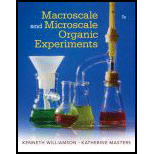
Macroscale and Microscale Organic Experiments
7th Edition
ISBN: 9781305577190
Author: Kenneth L. Williamson, Katherine M. Masters
Publisher: Brooks Cole
expand_more
expand_more
format_list_bulleted
Question
Chapter 3, Problem 4Q
Interpretation Introduction
Interpretation:
The observed and the true melting point due to the rapid heating of the melting point bath should be compared.
Concept introduction:
Temperature at which an element changes from the solid state to the liquid state is known as melting point or sometimes liquefaction point. At the melting point, both solid and liquid phase coexist in equilibrium. It depends on the pressure and is normally defined at the standard pressure
Expert Solution & Answer
Want to see the full answer?
Check out a sample textbook solution
Students have asked these similar questions
3. A student is trying to identify an unknown solid based on its melting point. She noted that the
compound began to melt at 172°C and finished melting at 177°C. Knowing it is possible for there
to be impurities in the sample, is this compound more likely to be camphor or hydroquinone.
Explain your reasoning.
4. A young chemist has synthesized what he believed to be acetaminophen. He measured the
melting point of this newly formed compound to be 163-178°C. If the literature value for the
melting point of acetaminophen = 169-170.5°C, would the young chemist be wise to consume
this product for headache relief? Why or why not?
A student obtained a solid product in a laboratory synthesis. To verify the identity
of the solid, she measured its melting point and found that the material melted over a
10°C range. After it had cooled, she measured the melting point of the same sample again
and found that this time the solid had a sharp melting point at the temperature that is
characteristic of the desired product. Why were the two melting points different? What
was responsible for the change in the melting point?
3. Pure benzophenone melts at 48.1°C. Your sample of benzophenone began to
freeze at 47.0°C. When you repeated this measurement, the sample again began
to freeze at 47.0°C. Give at least two reasonable explanations for this observation.
Chapter 3 Solutions
Macroscale and Microscale Organic Experiments
Knowledge Booster
Similar questions
- Due to the fact that the liquid you used was a volatile one, it will not completely recondense. Some of the liquid remains in the vapor phase, even at room temperature. If you were able to correct for this by making the vapors recondense completely, would your final molar mass value be greater than, less than or the same as the value you determined? Explain your reasoning.arrow_forwardCite Five Real-Life Applications of Cooling Curve and Freezing Point Determination.arrow_forward4. When performing a melting point on a solid compound using a melting point apparatus, two melting point determinations were made. One sample, which was 1 mm in height in the capillary, possessed a melting point of 200.0-200.5°C. The other sample was 25 mm in height. What would you expect the approximate melting point to be for this sample, assuming identical heating rates of 1°/min? (Hint: heat is applied from the bottom of the sample) (Give an actual numerical approximation!) 5. For the same solid compound as the question above, if the 1 mm sample was heated at 60° per minute on a melting point apparatus, what would you expect for an approximate melting point? (note that at this heating rate, the sample will melt rather quickly, but again give an actual numerical approximation)arrow_forward
- Which of the melting point capillaries in the picture below is filled to the proper level for taking a melting point on a MelTemp melting point apparatus? OB OC OA 12 01489 5arrow_forward9)Who measures melting points?arrow_forwardChemistry 5. You melt the substance and de-coloration occurs. Unfortunately, you weren’t paying attention and miss the melting point. Should you start over or re-melt it? Or both are options ‘okay’? 6. When measuring the melting point of a substance, it suddenly disappears. What has happened? Can you still measure the melting point? If so, how? 7. We should not re-use a sample in a capillary tube for melting point measurement. Why not? 8. It takes significant amount of time for the melting point apparatus to cool down before next measurement if your new sample has a lower melting point than your previous one. What can you do to reduce this time in between measurements when many samples of different melting points are used?arrow_forward
- Naphthalene melts at 353 K. The vapor pressure of the liquid is 9329.0 Pa at 407 K and 28,638 Pa at 442 K. The vapor pressure of the solid is 3.13 Pa at 286 K and 726.3 Pa at 349 K. Calculate the triple point temperature. Calculate the triple point pressure.arrow_forwardIs it possible to freeze ammonia? What conditions would be necessary for frozen ammonia?arrow_forwardWhat effect does the presence of impurity have on the melting point?arrow_forward
arrow_back_ios
SEE MORE QUESTIONS
arrow_forward_ios
Recommended textbooks for you
 EBK A SMALL SCALE APPROACH TO ORGANIC LChemistryISBN:9781305446021Author:LampmanPublisher:CENGAGE LEARNING - CONSIGNMENT
EBK A SMALL SCALE APPROACH TO ORGANIC LChemistryISBN:9781305446021Author:LampmanPublisher:CENGAGE LEARNING - CONSIGNMENT World of Chemistry, 3rd editionChemistryISBN:9781133109655Author:Steven S. Zumdahl, Susan L. Zumdahl, Donald J. DeCostePublisher:Brooks / Cole / Cengage Learning
World of Chemistry, 3rd editionChemistryISBN:9781133109655Author:Steven S. Zumdahl, Susan L. Zumdahl, Donald J. DeCostePublisher:Brooks / Cole / Cengage Learning Chemistry: Principles and PracticeChemistryISBN:9780534420123Author:Daniel L. Reger, Scott R. Goode, David W. Ball, Edward MercerPublisher:Cengage Learning
Chemistry: Principles and PracticeChemistryISBN:9780534420123Author:Daniel L. Reger, Scott R. Goode, David W. Ball, Edward MercerPublisher:Cengage Learning- Chemistry: Matter and ChangeChemistryISBN:9780078746376Author:Dinah Zike, Laurel Dingrando, Nicholas Hainen, Cheryl WistromPublisher:Glencoe/McGraw-Hill School Pub Co

EBK A SMALL SCALE APPROACH TO ORGANIC L
Chemistry
ISBN:9781305446021
Author:Lampman
Publisher:CENGAGE LEARNING - CONSIGNMENT

World of Chemistry, 3rd edition
Chemistry
ISBN:9781133109655
Author:Steven S. Zumdahl, Susan L. Zumdahl, Donald J. DeCoste
Publisher:Brooks / Cole / Cengage Learning

Chemistry: Principles and Practice
Chemistry
ISBN:9780534420123
Author:Daniel L. Reger, Scott R. Goode, David W. Ball, Edward Mercer
Publisher:Cengage Learning

Chemistry: Matter and Change
Chemistry
ISBN:9780078746376
Author:Dinah Zike, Laurel Dingrando, Nicholas Hainen, Cheryl Wistrom
Publisher:Glencoe/McGraw-Hill School Pub Co